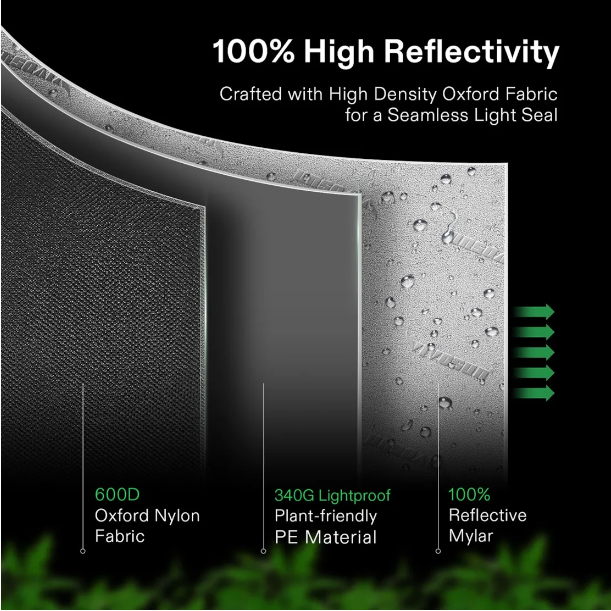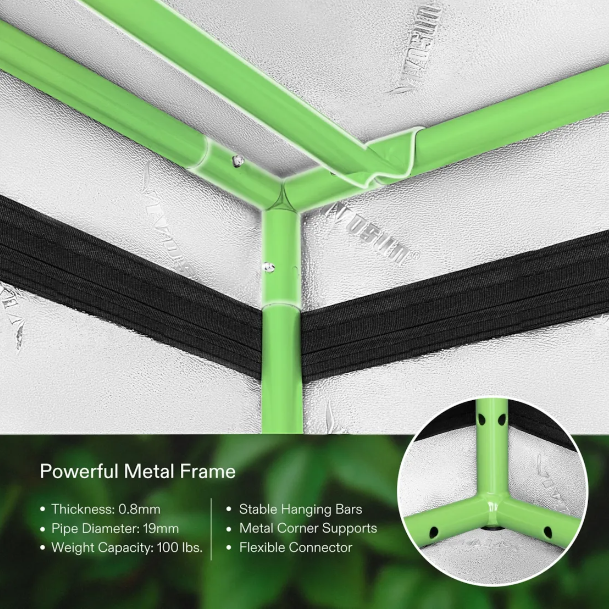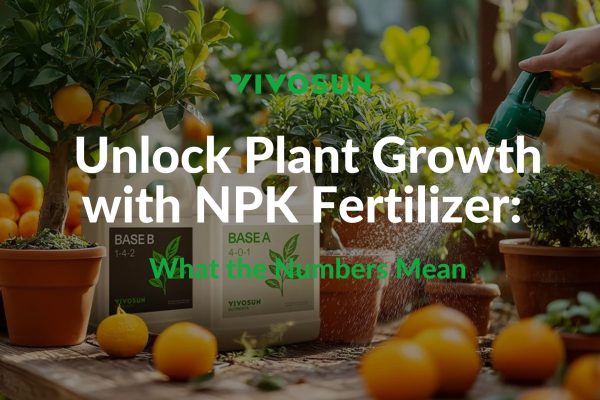Finding the right grow tent can be difficult to do – with so many options out there it’s easy to get overwhelmed with choice. We’re here to help you break down the most important parts of selecting your next grow tent in a simple, easy-to-read way.
We will look at what a grow tent is, what key considerations you should have when finding your grow tent, what the most important features are of a grow tent, and some key tips once you have a grow tent! Let’s take a look at the options we offer at VIVOSUN.
[wptb id=3388]
[wptb id=3389]
[wptb id=3391]
[wptb id=3392]
What Is a Grow Tent? – Grow Tent Buying Guide for Beginners 2023
A grow tent is essentially a container for your plants. It is a rigid framework, usually made of plastic or metal, encased in a fabric outer cover.
They are easy to set up and are designed to contain an environment in a way that helps plants grow strong and healthy. This is done by lining the interior with reflective material to keep light in and heavy-duty exterior fabric to retain humidity levels.
Grow tents differ from grow spaces or grow cabinets in significant ways. Grow spaces refers to any kind of space where you grow plants – a basement, garage, or closet all count as grow spaces. These are less effective than grow tents at containing light and temperature and humidity because they are not designed to do so.
A grow cabinet is a stealthy way to grow, but they are small and do not allow a lot of room for large plants or yields.
What Are the Key Considerations When Buying a Grow Tent? – Grow Tent Buying Guide for Beginners 2023
There are four considerations that need to be accounted for when buying a grow tent – these will help you decide what kind of tent will be right for your situation. Before buying, consider:
Size – what size space do you need;
Material – is the material of good enough quality;
Equipment capacity – will you be able to fit all your equipment in the tent without worrying whether it will collapse;
and Price – how does the price compare to an equivalent tent?
Let’s take a look at the details.
Consideration #1: Grow Tent Size
VIVOSUN offers a ton of different tent sizes that can fit any space you have. Obviously, the larger the tent, the more space you have to grow plants. Before you purchase your new tent, measure the space you plan to place your tent. The tent should be slightly smaller than the space you will place it in.
Additionally, if you plan to grow cannabis, be aware that most states have a legal limit on the number of plants you can grow at a given time.
Different growers have different goals, and different plants have different requirements and one single tent may not be enough. Many growers use multiple tents for different stages of growth – one for vegetative growth and another for flowering/fruiting, and maybe even another for drying.
Let’s determine the different sizes of tents that VIVOSUN sells, and the number of plants each one can hold.
| Tent size | Number of plants |
| 2’ x 2’ | 1 – 2 plants |
| 2’ x 4’ | 2 – 4 plants |
| 3’ x 3’ | 2 – 4 plants |
| 4’ x 4’ | 4 – 6 plants |
| 5’ x 5’ | 4 – 8 plants |
| 4’ x 8’ | 4 – 8 plants |
| 8’ x 8’ | 9 – 15 plants |
| 10’ x 10’ | 12 – 16 plants |
Tents also come in multiple styles. Some models of tents are designed with multiple chambers that can hold plants in different stages or different types of plants that have different requirements. We call these tents “2-in-1” tents.
2-in-1 tents are very convenient for organizing your plants into different types. They enable you to start seeds or grow small plants while still having space for larger ones.
Consideration #2: Material
The material should be your second consideration when looking at a new type of tent.
When we speak of materials, we are thinking of what exactly the tent is made of, this includes the frame and the cover.
For a good tent, you should look for thick, Oxford-type canvas material for the cover. “Oxford” is a type of weaving, also considered a basket weave, that is tight enough to be puncture resistant and to resist light leaks. We recommend a canvas with a 600D rating. The “D” stands for denier, a linear mass density of fibers. The higher the number, the higher the quality of the fabric.
Inside the cover, we recommend a Mylar lining. Mylar is a highly flexible and reflective material that helps utilize as much light as possible by reflecting it back to plants. The higher the reflectivity, the more efficient your lights will be.
Every brand has its own preferred pattern of Mylar. We at VIVOSUN like to use what we call a “Lychee” pattern, which, from our testing, we have found has the best reflectivity.

Thick fabric and a reflective Mylar should work together to help control any light leaks. A quality cover must be able to contain any light that is produced within the tent and must be able to protect the interior of the tent from external light. This is crucial for photoperiodic plants because light during night periods will disrupt the growing process.
Tent poles should be made of metal, preferably, rather than plastic. Plastic tends to be too flexible and weak to hold equipment. You don’t want your tent poles to snap when you’re not home!

Most tent manufacturers now do build their poles out of metal. Just make sure the poles are strong enough to meet whatever equipment you hang from them.
Tent poles can come in a number of different styles, such as powder-coated or painted – this is to keep your tent poles from rusting. You don’t want tent poles that are untreated, otherwise, they will rust in the humidity and moisture of the tent. Whether that means a powder coating or a painted pole, make sure it’s treated correctly.
Consideration #3: Equipment capacity
When we speak of equipment capacity, we refer to two things: how much weight your tent can handle and whether your tent has the capacity for controlling climate.
Each manufacturer has a recommended weight limit according to the materials it is made with. Metal poles are better than plastic because they can hold more weight.
Your tent should be able to hold the weight of your equipment, so if you plan to have large equipment to grow a lot of plants you should ensure your tent poles can handle that. We recommend a minimum of about 70 lbs carrying capacity. Our tents are rated to hold 100lbs reliably, but if you need more weight you can add extra cross bars, just make sure the frame can handle it.
Additionally, your tent should be able to maintain its environment. This means it should be able to control temperature and humidity. Temperature will likely be a bit tricky because most grow tents are not insulated, luckily, this isn’t such an issue because your plants will probably want to be at room temperature.
Humidity is easier to control. Using your equipment or by adding a humidifier or dehumidifier, you’ll be able to control humidity if your tent has well-sealed ports and zippers.
Zippers and ports should be well constructed and tightly sealed – heavy-duty zippers should be thickened to prevent leaks of any kind. Your tent will never be totally sealed, but it will be closed enough to make sure that you can control humidity.
Consideration #4: Price
Naturally, price is going to play a big factor whenever you are making a new purchase and a larger tent will cost more than a smaller one, as will the equipment. If you are first starting out, a smaller tent will be more cost effective and will still hold enough plants for you to recover your initial cost after the first harvest.
The cost of a tent may be a bit expensive initially but in time you will recover it and a quality tent is far more worthwhile than buying a cheap tent initially!
The Most Important Features of a Grow Tent – Grow Tent Buying Guide for Beginners 2023
Here we introduce what we believe are the most important features of any new grow tent. These features will help further your decision when selecting the right tent and you should expect that each tent should have them. These include ventilation ports and windows, a removable floor tray, and features that make setting up easy.
Feature #1: Ventilation ports and windows
Ventilation ports are usually located at the bottom of the tent and they allow for the flow of air as you use your ventilation equipment. It is important to have these ports because it helps equalize the pressure as well as allow for proper circulation of CO2.
Windows help makes viewing your plants more convenient. You don’t want to have to open and close your door over and over, which may also disturb your plants.
Feature #2: Removable floor tray
A removable floor tray helps make clean-up easier. Cleaning tents can be a headache and spills can cause problems later in your growing but a floor tray helps make clean up easier because you can simply remove it when you want to clean it.
Feature #3: Easy setup
Set up can be simplified with poles and materials designed to be so. For example, our tents include small ball bearings at the ends of the poles to allow set up and take down to be quick and easy, and stability to be maintained.
Key Tips for Your Grow Tent – Grow Tent Buying Guide for Beginners 2023
Keeping your grow tent in working order will be helpful to its longevity, making the tent more valuable the more you use it. Here are some key tips that will help you get the most out of your tent.
Tip #1: Clean often!
Tents can get dirty so don’t be afraid to use soapy water or even bleach to wipe down the inside of your tent between grows. This helps reduce the risk of pathogens like mildew or fungus or mites. It ensures that your plants have a sterile growing environment going forward, which will help you get the best harvests.
Tip #2: Insulate your grow space.
Insulate your grow space, not just the tent, if you’re struggling with maintaining temperature. Remember, most plants like room temperature so if your tent is in your house you shouldn’t struggle with providing the right heat. But if you grow in a garage your plants may become unhappy. Make sure the space is insulated, or create a small section around the tent out of blankets and other insulating material to help your plants stay warm during cold winters.
Tip #3: Patch pinholes as soon as you can.
Use an electrician’s tape or sew a denim patch over the hole if you notice that there are pinholes in your tent. The process is easy and can fix minor issues that come up with age.
Tip #4: Your tent size determines your ventilation requirements.
The square footage of your tent tells you exactly how strong your fan needs to be. Fan strength is measured in Cubic Feet per Minute (CFM), which should about match the size of your tent. So if you have a 2’ x 4’ x 6’ tent, your cubic feet is (2x4x6) 48, and your CFM should be about that same amount.
We hope this has been a useful guide to purchasing your next tent. We’re very happy you stopped by and we know you’ll find exactly what you’re looking for on VIVOSUN.com, so come check us out!
If you have any questions, please don’t hesitate to reach out to us!
And be sure to check out our other blog posts for useful tips on becoming a great grower!
Subscribe to the VIVOSUN newsletter for growing tips, grower stories, and special offers, and get 12% off your first order!
We love the new VIVOSUN Smart Grow System and we are certain that you too will love it once you try it.
And join our Facebook farmer’s community for even more exclusive contests and prizes!
Download VIVOSUN App to get 18% off and explore more information!







